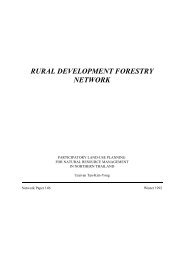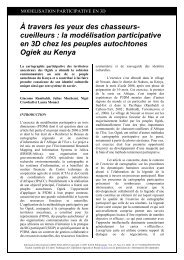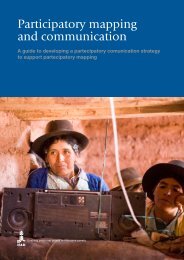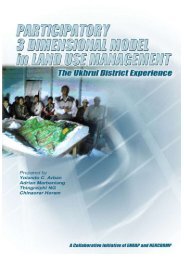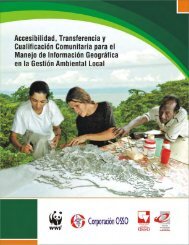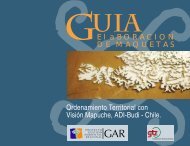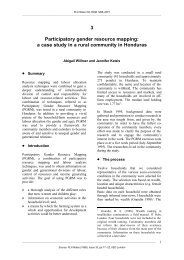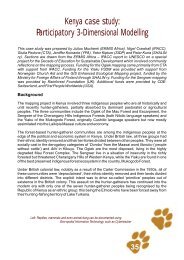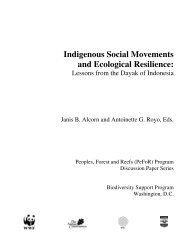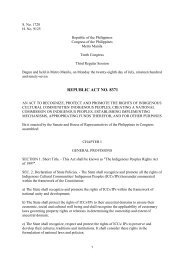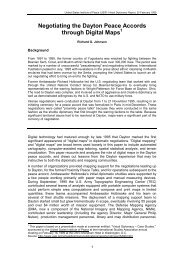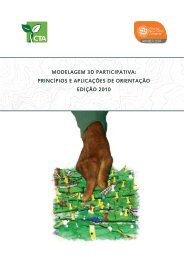steps to sustainable and community-based ntfp management
steps to sustainable and community-based ntfp management
steps to sustainable and community-based ntfp management
Create successful ePaper yourself
Turn your PDF publications into a flip-book with our unique Google optimized e-Paper software.
APPENDIX Imeasurement of size for the younger, stemless plants. Once a stem is apparent, however,stem height or length is used.Other plant conditions. Other observations <strong>and</strong> measurements should be made, if desired, ofother conditions such as a plant’s age, sex, any evidence of poor reproduction or health,or any signs of previous harvesting (see Section E.3.4).Plant seed production rates. The seed production rates of a plant population can be estimatedby collecting seeds from seed-bank soil cores or seed traps, as described below (Sutherl<strong>and</strong>,1996):• Seed-bank soil cores. Soil cores are useful for estimating the density of seeds in the seedbank. If placed under canopies, they can also be used <strong>to</strong> estimate the seed productionof individual trees. Soil cores are taken using a soil corer, or a sheet-metal cylinder ofdiameter 2 <strong>to</strong> 20 cm (depending upon seed size) with one sharpened rim. This corer ispushed in<strong>to</strong> the soil at a specified depth that can range from 5 <strong>to</strong> 20 cm. Care must betaken in sampling soil cores because of variation in space <strong>and</strong> time. Seed traps shouldtherefore be sampled objectively, <strong>and</strong> taken at the appropriate time or times over theseason of seed production. Usually, many samples are needed. The soil core should beseparated in<strong>to</strong> layers (e.g. 0-2, 2-5, >5 cm depth) <strong>and</strong> the number of seeds in each layercounted. This is done by wet sieving, or running each soil layer under a running tapthrough stacked layers of mesh <strong>to</strong> sort seeds from soil. The layers of mesh should beof different sizes, starting with the largest size as the <strong>to</strong>p layer. The seeds should thenbe sorted, identified <strong>and</strong> counted. To identify seeds, it may be necessary <strong>to</strong> germinatethem.• Seed traps. These are useful for estimating the density per unit time of seeds arrivingat the soil surface. Seed traps are placed on the soil surface. The traps can be madein a number of ways, but sticky traps are most popular. A sticky trap is a petri dishwith a circle of sticky paper inside; this allows removal <strong>and</strong> replacement of the stickypaper. As with soil cores, care should be taken with sampling because of variation inspace <strong>and</strong> time. Seed traps should therefore be sampled objectively, <strong>and</strong> taken at theappropriate time or times over the season of seed production. Usually many samplesare needed. The seeds should be sorted, identified <strong>and</strong> counted. To identify seeds, itmay be necessary <strong>to</strong> germinate them.Plant germination rates. The germination rate of a population of seeds (or the proportionof living seeds out of the <strong>to</strong>tal number of seeds sampled in the seed production studiesdescribed above) can be estimated using either seed viability tests or germination tests, asdescribed below (Sutherl<strong>and</strong>, 1996):• Seed viability tests. Two types of dye, tetrazolium or indigocarmine, can be used <strong>to</strong>determine whether seeds are dead or alive. Tetrazolium (triphenyltetrazolium chloride)stains living tissue red <strong>and</strong> remains colourless if the seed is dead. Indigocarmineremains blue if the seed is dead but goes colourless in living tissue.186



